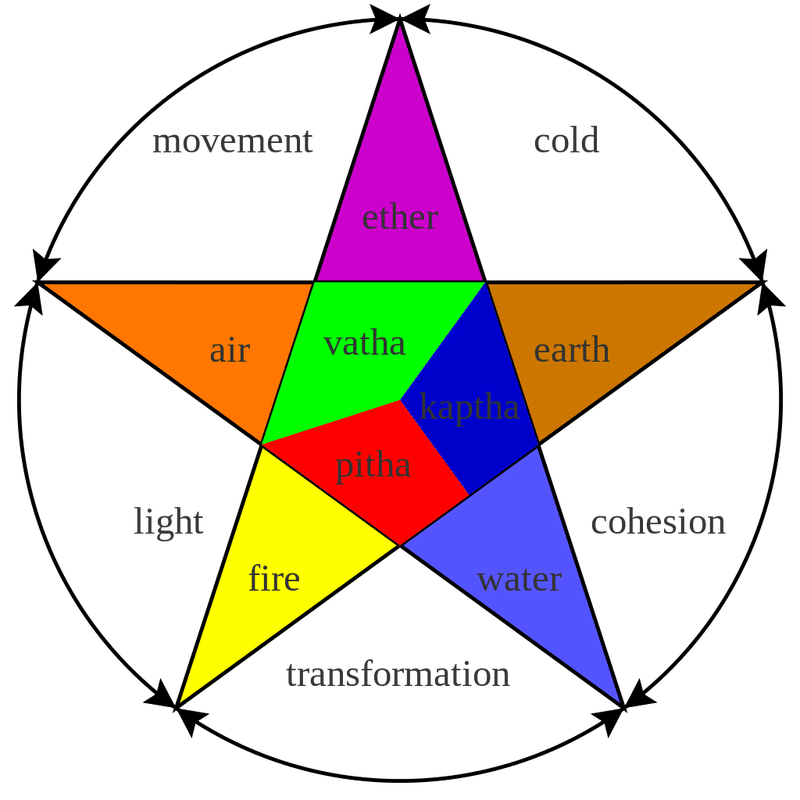
Ayurveda : Indian medical system
India is the birthplace of four great civilisations, and has a unique medical system called “Ayurveda”, which is different from Western medicine.
Whereas western medicine takes symptomatic measures, Ayurveda tries to maintain the balance of whole body and mind.
At first, I show the basic concepts of Ayurveda and then discuss its raison d’etre.
three doshas
Ayurvedic theory considers the body to be made up of three components called “three doshas”.
Doshas are the building blocks of our body. There are three kinds of doshas, so we call them "three doshas".
vatha (air/ether: kinetic energy)
It is composed of air and ether ( ether = void or not existing/no existence ). It has light, dynamic, fast, dry and cold properties.It concerns movement, transport and elimination in the body.
pitha (fire/water: conversion energy)
It is composed of fire and water.It has light, dynamic, heat and sharp properties. It concerns digestion and metabolism in the body.
kaptha (earth/water: bonding energy)
It is composed of earth and water. It has heavy, slow, wet, cold and viscous properties. It concerns bonding, assimilation and immunity in the body.
[supplement]
Although pitha and kaptha both have the property of “water”, each “water” is different. The water in pitha refers to “bile”, probably as the most common term for digestive juices. On the other hand, the water in kaptha refers to mucus or sputum. Probably as the most common symbol of viscosity.
panchamahabhuta (five elements)
“Panchamahabhuta” are the five elements that make up all things in Ayurvedic theory. Although doshas are the building blocks of our body, they are not elements. Each doshas are composed of "panchamahabhuta".
One of the most famous pre-medieval views of matter is the theory of the four elements: fire, water, earth and air. The theory of panchamahabhuta adds one element to the four elements theory.
The one is “ether” which means void or not existing.
The relationship between the three doshas and panchamahabhuta can be organized as shown in the figure below (Source: Wikipedia).

Ayurvedic approach to food
In Ayurvedic theory, nutritional intake through food is considered by the effect of “agni (fire)”, which composes “pitha”. When agni is working properly, food is fully digested and converted into “ojas (entelechy)”. On the other hand, if agni can’t work properly, food is converted into “ama (toxin)”. Ama can cause excretion problems and lead to disease.
How Ayurveda treats disease?
Ayurvedic theory considers that disease results from the abnormalities in the intake and excretion of food. Thus, treatments can be divided into two main categories: ingestion and excretion.
palliative treatment (improving ingestion)
Palliative treatment makes patients improve their diets mainly. There are two methods.
One is fasting treatment which aims to decrease the excess “dhatus (nutrients or components of body)”. The other is nourishing treatment which aims to increase the lack of “dhatus”.
attenuation treatment (improving excretion)
Attenuation treatment is mainly focused on improving elimination. It involves a variety of procedures such as hair washing, oil massage, laxatives and bloodletting.
the raison d’etre of Ayurveda
In terms of scientific evidence, Ayurvedic theory is fragile. Although some Ayurvedic theory is considered to be ineffective or scientifically incorrect, it has a long history which contains many improvements and rules of thumb.
Whereas, western medicine is based on scientific evidence. However, the evidence is mainly based on statistical analysis which doesn’t focus on individual cases.
This current situation is one of the reasons why western medicine is focused on symptomatic treatment. They focus on symptoms, and apply treatments that have been statistically proven to work. But they are not good at taking into account individual properties.
In considering how a person should live a healthy life, the individual property is the most important.
Ayurvedic method is a system that makes the person well via personalised treatment. I think it is an important raison d’etre of Ayurveda.
この記事が気に入ったらサポートをしてみませんか?
